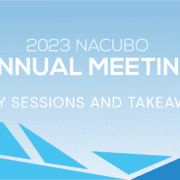4 Key Sessions and Takeaways from NACUBO 2023 Conference
By: Nicole Verrett, Vice President of Client Engagement & Martin Smith, Vice President of Campus Partnerships
During the 2023 NACUBO conference, we had the opportunity to attend many sessions that delved into the current challenges facing higher education. We will focus on four key sessions that stood out, highlighting their major takeaways from this year’s conference that will be invaluable for institutions as they navigate the challenges and opportunities that lie ahead in the 2023-2024 school year.
Break the Pandemic-Enrollment Cliff Doom Loop
This session addressed the pressing challenge faced by higher education institutions in regaining pre-pandemic enrollment levels. Attendees, including CFOs from various campuses, shared creative solutions that can prove instrumental in overcoming this hurdle. One notable strategy discussed was aligning technology investments with campus initiatives to enhance overall efficiency. Moreover, catering to the needs of underserved students emerged as a crucial aspect to drive enrollment growth.
Key Takeaway: Embracing Change to Enhance Efficiency
In the face of the enrollment cliff, higher education campuses must do more than rely on marketing alone to overcome the challenges. A comprehensive approach is crucial, with a focus on both program offerings and operational excellence. Robert Heil, CEO of FAS (Financial Aid Services), highlights four critical factors that demand increased attention as institutions brace for the enrollment cliff: College Going Rates, Centralizing Pathway Programs, Loss of Pricing Power, and the imminent Staffing Crisis affecting financial aid and student business operations. Embracing these necessary changes presents opportunities for growth and empowers institutions to navigate the obstacles posed by the evolving workforce landscape.
Higher Ed Workforce Challenges: Opportunity, Chaos, or Something in Between?
This session delved into the ongoing struggles of employee recruitment and retention in the higher education sector. Attendees gained insights into effective strategies employed by chief business officers and chief human resource officers to attract and retain talent in this highly competitive job market. One emerging solution discussed was outsourcing financial aid operations to streamline processes and improve overall efficiency.
Key Takeaway: Staffing Challenges Deserve Solutions
Higher education institutions across the nation are grappling with significant staffing challenges, especially in today’s competitive job market. Recruitment and retention of employees has become top priorities for campus leaders. As highlighted in our latest eBook “Challenges Deserve Solutions.” The National Association of Student Financial Aid Administrators (NASFAA) in March 2022, polled 500 institutions with a vast majority of universities today stating that they cannot find enough qualified applicants to fill open roles. To tackle this issue effectively, institutions should strategically align with like-minded partners to mitigate operational and staffing challenges
The Charter of a Post-Pandemic CFO: Supporting the Mission through Strategic Staffing
The third session emphasized the critical role that post-pandemic chief financial officers play in ensuring their institutions thrive despite economic uncertainties and declining enrollment numbers. Business officers must confront and embrace data to identify under-resourced areas of their institutions and unlock investments strategically. Additionally, leveraging the relationship between student employment and student success can further support institutional efficiencies and financial sustainability.
Key Takeaway: Collaboration and Data-Driven Decisions
CFOs need to collaborate closely with Financial Aid Officers (FAO) to navigate through upcoming changes effectively. By creating streamlined systems and processes, institutions can adapt to the evolving higher education landscape. Furthermore, data-driven decisions will be instrumental in overcoming financial challenges and breaking the stigma of the “budget blocker.”
Building Bridges to Help Our Students: Partnering Student Accounts and Financial Aid
This session centered around student support services, highlighting the need for optimizing Financial Aid Officers (FAO) and Student Business Services (SBS) with one-stop shops and comprehensive office assessments. Ensuring the best possible support for students remains a top priority for higher education institutions.
Key Takeaway: Prioritizing Student Support
Students come first, always. In our latest comprehensive report, the norms expected by today’s students have been formed by their experience as voracious consumers in a marketplace defined by a multitude of on-demand eCommerce and entertainment experiences. Institutions must prioritize student support services to enhance the overall experience of their students. By building bridges between Student Accounts and Financial Aid, institutions can create a seamless support system that caters to the needs of their student population.
The NACUBO conference provided us with great insights into the challenges and opportunities within higher education and how FAS can further support institutions. The key takeaways from these sessions will undoubtedly guide institutions and stakeholders in navigating the ever-evolving landscape of higher education. By embracing innovative solutions, collaborating, and making data-driven decisions, we can collectively support the success of both institutions and students on their educational journey. Challenges deserve solutions, and with the lessons learned at NACUBO, we are better equipped to overcome them.








